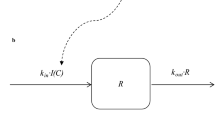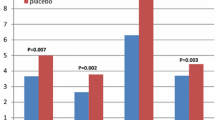Abstract
Objective and design
Comparison of bilastine and cetirizine in inhibiting skin wheal and flare responses over 24 h.
Subjects
Twenty-one healthy male volunteers (aged 19–44 years).
Treatment and methods
Volunteers were randomised to receive single oral doses of 20 or 50 mg bilastine, 10 mg cetirizine or placebo before provocation of wheal and flare responses to 100 mg/ml histamine by skin prick 1.5, 4, 8, 12 and 24 h later.
Results
There were no significant differences between overall inhibitions of wheal or flare by 20 mg bilastine and 10 mg cetirizine. Bilastine was faster in onset than cetirizine, inhibitions of wheal and flare at 1.5 h being 89 ± 3 versus 44 ± 14% (P = 0.011) and 85 ± 4 versus 45 ± 14% (P = 0.016), respectively (Student’s t test). At 1.5 h, both wheals and flares were inhibited by >70% in 11/12 volunteers taking bilastine and 3/11 taking cetirizine (P = 0.003, Fisher’s exact test). There were no significant differences between the drugs at later times. Bilastine 50 mg had a longer duration of action than bilastine 20 mg.
Conclusions
Both 20 mg bilastine and 10 mg cetirizine are effective and of long duration in reducing histamine-induced wheal and flare responses, the major difference between the two drugs being the more rapid onset of action of bilastine.




Similar content being viewed by others
References
Bousquet J, Khaltaev N, Cruz AA, Denburg J, Fokkens WJ, Togias A, et al. Allergic rhinitis and its impact on asthma (ARIA) 2008 update (in collaboration with the World Health Organization, GA(2)LEN and AllerGen). Allergy. 2008;63(Suppl 86):8–160.
Clough GF, Boutsiouki P, Church MK. Comparison of the effects of levocetirizine and loratadine on histamine-induced wheal, flare, and itch in human skin. Allergy. 2001;56(10):985–8.
Denham KJ, Boutsiouki P, Clough GF, Church MK. Comparison of the effects of desloratadine and levocetirizine on histamine-induced wheal, flare and itch in human skin. Inflamm Res. 2003;52(10):424–7.
Purohit A, Melac M, Pauli G, Frossard N. Twenty-four-hour activity and consistency of activity of levocetirizine and desloratadine in the skin. Br J Clin Pharmacol. 2003;56(4):388–94.
Darsow U, Ring J, Scharein E, Bromm B. Correlations between histamine-induced wheal, flare and itch. Arch Dermatol Res. 1996;288(8):436–41.
Kumar P, Shen Q, Pivetti CD, Lee ES, Wu MH, Yuan SY. Molecular mechanisms of endothelial hyperpermeability: implications in inflammation. Expert Rev Mol Med. 2009;11:e19.
Entrican JH, Simpson JG, Stalker AL. The effects of histamine and bradykinin on the post-capillary venule. J Pathol. 1971;104(3):3.
Raud J. Intravital microscopic studies on acute mast cell-dependent inflammation. Acta Physiol Scand Suppl. 1989;578:1–58.
Glyn MC, Lawrenson JG, Ward BJ, Clark P. Rho kinase-mediated reduction in cardiac capillary endothelial cell dimensions, in situ, against flow. Microcirculation. 2008;28:1–16.
Schmelz M, Michael K, Weidner C, Schmidt R, Torebjork HE, Handwerker HO. Which nerve fibers mediate the axon reflex flare in human skin? Neuroreport. 2000;11(3):645–8.
Schmelz M. A neural pathway for itch. Nat Neurosci. 2001;4(1):9–10.
Corcostegui R, Labeaga L, Innerarity A, Berisa A, Orjales A. Preclinical pharmacology of bilastine, a new selective histamine H1 receptor antagonist: receptor selectivity and in vitro antihistaminic activity. Drugs R D. 2005;6(6):371–84.
Corcostegui R, Labeaga L, Innerarity A, Berisa A, Orjales A. In vivo pharmacological characterisation of bilastine, a potent and selective histamine H1 receptor antagonist. Drugs R D. 2006;7(4):219–31.
Zuberbier T, Oanta A, Bogacka E, Medina I, Wesel F, Uhl P, et al. Comparison of the efficacy and safety of bilastine 20 mg vs levocetirizine 5 mg for the treatment of chronic idiopathic urticaria: a multi-centre, double-blind, randomized, placebo-controlled study. Allergy. 2010;65(4):516–28.
Horak F, Zieglmayer P, Zieglmayer R, Lemell P. The effects of bilastine compared with cetirizine, fexofenadine, and placebo on allergen-induced nasal and ocular symptoms in patients exposed to aeroallergen in the Vienna Challenge Chamber. Inflamm Res. 2010;59(5):391–8.
Kuna P, Bachert C, Nowacki Z, van Cauwenberge P, Agache I, Fouquert L, et al. Efficacy and safety of bilastine 20 mg compared with cetirizine 10 mg and placebo for the symptomatic treatment of seasonal allergic rhinitis: a randomized, double-blind, parallel-group study. Clin Exp Allergy. 2009;39(9):1338–47.
Bachert C, Kuna P, Sanquer F, Ivan P, Dimitrov V, Gorina MM, et al. Comparison of the efficacy and safety of bilastine 20 mg vs desloratadine 5 mg in seasonal allergic rhinitis patients. Allergy. 2009;64(1):158–65.
Jauregizar N, de la Fuente L, Lucero ML, Sologuren A, Leal N, Rodriguez M. Pharmacokinetic-pharmacodynamic modelling of the antihistaminic H1-effect of bilastine. Clin Pharmacokinet. 2009;48(8):543–54.
Staevska M, Popov TA, Kralimarkova T, Lazarova C, Kraeva S, Popova D, et al. The effectiveness of levocetirizine and desloratadine in up to four-times conventional doses in difficult-to-treat urticaria. J Allergy Clin Immunol. 2010;125:676–82.
Zuberbier T, Asero R, Bindslev-Jensen C, Walter CG, Church MK, Gimenez-Arnau AM, et al. EAACI/GA(2)LEN/EDF/WAO guideline: management of urticaria. Allergy. 2009;64(10):1427–43.
Gillard M, Van Der Perren PC, Moguilevsky N, Massingham R, Chatelain P. Binding characteristics of cetirizine and levocetirizine to human H1 histamine receptors: contribution of Lys191 and Thr194. Mol Pharmacol. 2002;61(2):391–9.
Church MK. Safety and efficacy of bilastine: a new H1-antihistamine for the treatment of allergic rhinoconjunctivitis and urticaria. Expert Opin Drug Safety. 2011;10:779–93.
Schinkel AH. P-Glycoprotein, a gatekeeper in the blood-brain barrier. Adv Drug Deliv Rev. 1999;36(2–3):179–94.
Chen C, Hanson E, Watson JW, Lee JS. P-glycoprotein limits the brain penetration of nonsedating but not sedating H1-antagonists. Drug Metab Dispos. 2003;31(3):312–8.
Acknowledgments
The author wishes to thank Drs. D. McLaverty, A.J. Stewart and B. Colgan of MDS Pharma Services (Belfast, Northern Ireland), and Román Valiente (Faes Farma SA, Department of Research and Development, Department of Clinical Research, Leioa, Spain) for their valuable comments and advice.
Author information
Authors and Affiliations
Corresponding author
Additional information
Responsible Editor: Andras Falus.
Rights and permissions
About this article
Cite this article
Church, M.K. Comparative inhibition by bilastine and cetirizine of histamine-induced wheal and flare responses in humans. Inflamm. Res. 60, 1107–1112 (2011). https://doi.org/10.1007/s00011-011-0373-y
Received:
Revised:
Accepted:
Published:
Issue Date:
DOI: https://doi.org/10.1007/s00011-011-0373-y




